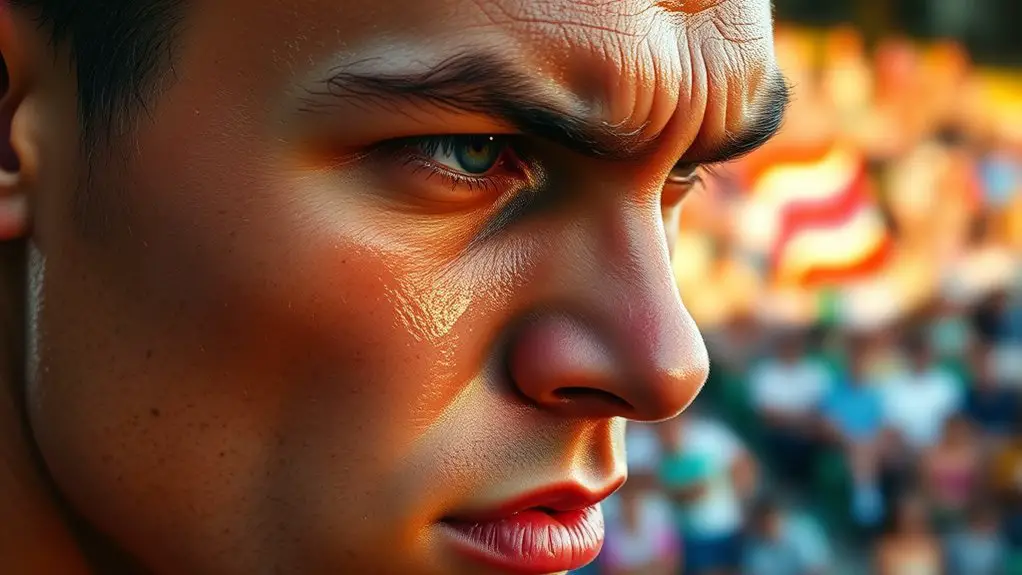Visualization is a key part of elite training programs because it taps into your brain's ability to create powerful mental images. By picturing success, you improve your focus and confidence while reducing anxiety. This mental rehearsal sharpens your skills and prepares you for real challenges, enhancing your overall performance. When you visualize, you can experience the sensations of success, making you instinctively ready to excel. There's much more to explore about how visualization can elevate your game.
The Science Behind Visualization Techniques
Visualization techniques are powerful tools that leverage the mind's ability to create vivid mental images, enhancing performance in elite training programs. By understanding cognitive neuroscience, you tap into how your brain processes imagery, making these techniques effective for releasing your potential. When you visualize, you're not just daydreaming; you're engaging in a sophisticated form of imagery processing that helps your brain rehearse actions and outcomes.
This mental rehearsal strengthens neural pathways, making your performance more instinctual when it counts. You can imagine the freedom of executing skills flawlessly, feeling the sensations, and experiencing the emotions tied to your success. Moreover, by engaging in visualization, you can actively train the brain for success, enhancing overall athletic performance.
As you practice these techniques, you'll discover how they empower you to overcome mental barriers and embrace your capabilities. Whether it's on the field or in life, visualization can be your secret weapon, guiding you toward the freedom and mastery you desire.
Enhancing Performance Through Mental Imagery
Mental imagery serves as a powerful means to enhance performance, building on the insights gained from visualization techniques. By engaging in mental imagery, you can sharpen your skills and unleash your potential. This practice not only cultivates mental clarity but also boosts cognitive focus, allowing you to perform at your best.
Mental imagery is a powerful tool to enhance performance, sharpen skills, and boost cognitive focus for optimal results.
- Visualize successful outcomes to create a positive mindset.
- Break down complex tasks into manageable mental segments.
- Use imagery to rehearse strategies and techniques before execution.
- Strengthen neural pathways associated with specific skills.
- Create a vivid mental environment that mirrors real-life conditions.
Incorporating these strategies into your training can lead to improved performance and a greater sense of freedom in your abilities. Embrace mental imagery as a tool to elevate your game, helping you stay focused and clear-minded, ultimately enhancing your performance on any stage. Additionally, practicing mindfulness techniques can further enhance your ability to utilize mental imagery effectively.
Building Confidence and Reducing Anxiety
Many elite athletes find that building confidence and reducing anxiety are fundamental components of their training regimen. When you visualize success, you're not just dreaming; you're engaging in powerful confidence building. Imagining your best performance helps shift your mindset and prepares you for real-life challenges.
Anxiety management is equally important. Instead of letting nerves take control, you can use visualization techniques to calm your mind and focus your energy. Picture yourself handling pressure gracefully, and you'll feel more in control when it counts.
Both practices foster a mental environment where freedom thrives—freedom from self-doubt and fear of failure. By integrating these techniques into your routine, you empower yourself, transforming anxiety into a motivating force. Mindfulness meditation can further enhance this process by enhancing focus and reducing anxiety, allowing you to perform at your best. So, embrace visualization as a means of building your confidence and managing anxiety, and watch your performance soar.
Visualization in Sports: A Winning Strategy
While athletes often focus on physical training, incorporating visualization can be a game-changer in enhancing performance. By using effective visualization techniques, you can sharpen your mental focus, leading to improved outcomes in your sport. Imagine executing your skills flawlessly, and you'll find that your brain starts to recognize these scenarios as real experiences, boosting your confidence.
Consider these benefits of visualization:
- Enhanced mental clarity: Visualizing success helps eliminate distractions.
- Improved technique: Mentally rehearsing movements can lead to better execution.
- Stress reduction: Visualizing a peaceful, successful performance can calm pre-game nerves.
- Increased motivation: Seeing yourself achieve goals fuels your desire to train harder.
- Stronger resilience: Overcoming imagined challenges can prepare you for real-life competition. Additionally, combining visualization with meditation techniques can further enhance your mental conditioning and focus.
Applications of Visualization in Performing Arts
In the world of performing arts, visualization can markedly enhance your performance techniques. By mentally rehearsing your routines, you can boost your confidence and reduce anxiety, especially when facing an audience. This approach not only helps you perfect your skills but also empowers you to overcome stage fright.
Enhancing Performance Techniques
When you embrace visualization techniques in the performing arts, you release a powerful tool to enhance your performance. This approach taps into cognitive training, allowing you to refine skills and boost confidence. By picturing each movement and emotion, you open a gateway to deeper performance psychology, which can elevate your artistry.
- Visualize successful performances to build confidence.
- Use imagery to rehearse complex choreography.
- Envision emotional expressions to connect with your audience.
- Picture overcoming challenges during a performance.
- Create mental scenarios to prepare for unexpected events.
Incorporating these techniques not only sharpens your skills but also frees your creative spirit, letting you fully embody your artistic vision. Embrace this journey, and watch your performances transform!
Mental Rehearsal Benefits
As you incorporate mental rehearsal into your practice, you'll discover its profound benefits in the performing arts. This technique allows you to engage in mental imagery, vividly picturing each movement and emotion in your performance. By regularly using cognitive rehearsal, you're not just memorizing lines or choreography; you're deeply embedding the experience in your mind. You can explore different interpretations, refine your technique, and boost your confidence—all in the comfort of your own space. This freedom to experiment without the pressures of a live audience enhances your creativity and expression. Ultimately, mental rehearsal transforms your practice sessions into powerful tools for growth, letting you step into your artistic self with clarity and intention. Embrace it, and watch your artistry flourish!
Overcoming Stage Fright
While stage fright can feel overwhelming, visualization techniques can greatly ease your nerves and enhance your performance. By mentally rehearsing your act, you can build confidence and create a strong stage presence. Here are some effective strategies for fear management:
- Visualize yourself in front of an audience, receiving applause.
- Imagine the details of the venue, from the lights to the audience's expressions.
- Practice deep breathing techniques alongside your visualization.
- Envision overcoming challenges during your performance with poise.
- Reflect on past successes to reinforce your belief in your abilities.
Embracing these techniques not only helps diminish anxiety but also empowers you to express your artistry freely. Remember, every performer has faced stage fright; it's how you manage it that counts.
Visualization for Professionals in High-Stakes Environments
In high-stakes environments, visualization can be a game-changer for you. By employing mental rehearsal techniques, you can prepare for critical situations, reduce stress, and enhance your overall performance. Let's explore how these strategies can set you apart when it matters most. Additionally, by practicing visualization techniques, you can boost self-belief and prepare for challenges effectively.
Mental Rehearsal Techniques
Many professionals in high-stakes environments rely on mental rehearsal techniques to enhance performance and reduce anxiety. By employing mental imagery and cognitive rehearsal, you can visualize success and prepare for various scenarios. Here are some effective techniques you might consider:
- Visualization: Picture yourself succeeding in your tasks.
- Scenario Simulation: Mentally navigate potential challenges and responses.
- Positive Affirmations: Reinforce your capabilities and confidence.
- Breath Control: Integrate deep breathing to center your focus.
- Feedback Loop: Reflect on your mental rehearsals to refine your approach.
These techniques not only boost your readiness but also foster a sense of freedom by empowering you to take control of your performance. Embrace these tools to elevate your game in high-pressure situations.
Stress Reduction Strategies
Stress can creep into high-stakes environments, making it essential for professionals to adopt effective strategies for reduction. One powerful approach is incorporating mindfulness techniques into your routine. By focusing on the present moment, you can create a mental space that allows you to step back from stressors. Simple practices like deep breathing or guided imagery can ground you, helping to clear your mind and reduce anxiety.
Visualization plays a key role here; envisioning successful outcomes can ease your worries and foster a sense of control. Remember, it's about finding balance and reclaiming your mental freedom. With consistent practice, these strategies can transform your mindset, empowering you to face challenges head-on and thrive in high-pressure situations.
Performance Enhancement Benefits
While high-stakes environments can be intimidating, visualization can greatly enhance your performance by fostering both confidence and focus. By incorporating visualization techniques, you can tap into numerous cognitive benefits that help with goal setting and achieving your desired outcomes. Here are some key advantages:
- Increases mental clarity and decision-making
- Boosts self-confidence before critical moments
- Enhances focus, reducing distractions
- Improves muscle memory through mental practice
- Strengthens resilience against pressure
Embracing visualization isn't just about daydreaming; it's a strategic tool that empowers you to navigate challenges with ease. By regularly visualizing your goals, you'll find yourself more prepared and adaptable, allowing you to thrive in demanding situations.
Creating a Visualization Practice: Tips and Techniques
To kick off your visualization practice, it's essential to find a routine that suits your needs and goals. Start by carving out a specific time each day for your visualization exercises—consistency is key. Whether it's early morning or right before bed, make it a sacred part of your daily practice.
Begin with simple scenarios: picture yourself achieving a personal goal or performing flawlessly in a significant moment. Close your eyes, breathe deeply, and immerse yourself in the experience. Use all your senses to make the imagery vivid—feel the emotions and sensations.
You might also want to keep a journal to track your progress and insights, helping you refine your practice. Don't hesitate to experiment with different techniques, like guided imagery or affirmations, to see what resonates with you. Remember, this is your journey; embrace the freedom to create a visualization practice that truly empowers you.
Real-Life Success Stories: Athletes and Performers Who Use Visualization
Many elite athletes and performers have harnessed the power of visualization to elevate their game and achieve extraordinary success. You might be surprised by how many have shared their journeys through athlete testimonials and performer insights. Here are some inspiring examples:
- Michael Phelps: Visualized every race, breaking records while maintaining focus.
- Serena Williams: Used visualization techniques to prepare mentally for high-stakes matches.
- Jim Carrey: Wrote himself a check for $10 million, visualizing his success long before achieving it.
- Olympic Gymnasts: Regularly practice mental imagery to perfect their routines.
- Tony Hawk: Imagined landing tricks before attempting them, boosting confidence and performance.
These stories show how visualization isn't just a technique; it's a powerful tool for anyone looking to tap into their potential and break through limitations. Embrace this practice, and who knows what you might achieve!
Frequently Asked Questions
How Long Does It Take to See Results From Visualization?
You might start noticing short term benefits from visualization within a few weeks, like improved focus and reduced anxiety. As you practice regularly, those initial gains can lead to long term effects, such as enhanced performance and greater confidence over months or even years. It's about consistency and commitment; the more you visualize your goals, the more freedom you'll feel in achieving them. Embrace the journey, and you'll see the results unfold.
Can Visualization Techniques Be Used for Everyday Life Challenges?
Absolutely, visualization techniques can be powerful for everyday life challenges. While some might doubt their effectiveness, research shows that mental imagery can enhance problem-solving skills and boost mental resilience. By applying these daily, you can create a clearer vision of your goals and overcome obstacles more easily. Imagine tackling stress or anxiety with visualizations; it gives you the freedom to approach challenges with confidence and a positive mindset. Why not give it a try?
What Are Common Misconceptions About Visualization Practices?
You might think visualization's just about wishful thinking, but that's a myth debunking you should reconsider. Many believe mental imagery doesn't lead to real-world results, yet studies show it can enhance performance and problem-solving. It's not magic; it's a tool for clarity and focus. Embracing visualization can empower you, helping you tackle everyday challenges and pursue freedom in your goals. So, don't overlook the power of your imagination—it's more practical than you think!
Is There a Specific Time of Day Best for Visualization?
Studies show that 80% of successful athletes incorporate visualization into their morning routines. This suggests that starting your day with focused mental imagery can set a powerful tone. However, evening reflections also play an essential role; winding down and visualizing your goals before sleep can reinforce your intentions. Ultimately, the best time for you depends on when you feel most free and clear-headed to connect with your aspirations. Trust your instincts!
How Do I Measure My Progress With Visualization Exercises?
To measure your progress with visualization exercises, start by implementing progress tracking methods. Keep a journal detailing your visualization sessions, noting the feelings and clarity you experience each time. You can also establish visualization metrics, like how vividly you can picture your goals or the emotional response generated. By consistently reviewing your notes, you'll see growth and refinement in your skills, allowing you the freedom to adjust your practice for even better results.




